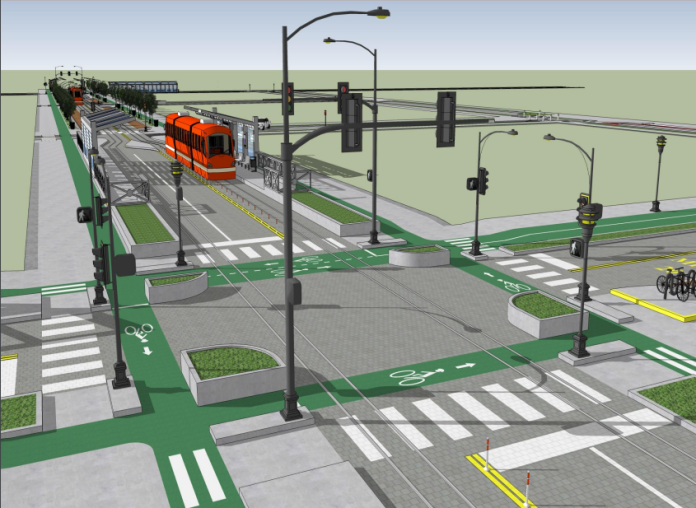Editor’s note: Last week, Seattle Bike Blog interviewed Joe Mangan regarding his proposal to re-envision NE 65th St and surrounding streets near Roosevelt High School. This article provides a deeper look into his proposal to give the streets a true Vision Zero treatment.
Between 2013 and 2016, sixty-eight people were hospitalized as a result of collisions on NE 65th St, and a local father, Andy Hulslander, was killed as he biked home from work. In 2016, the Roosevelt and Ravenna-Bryant Community Associations wrote a joint letter to Councilmembers Rob Johnson and Mike O’Brien requesting action to improve safety. In particular, residents asked the city to address excessive speeding, insufficient parking and safe crossings, unsafe pedestrian and bike infrastructure, long waits for walk signals, and dangerous intersections.
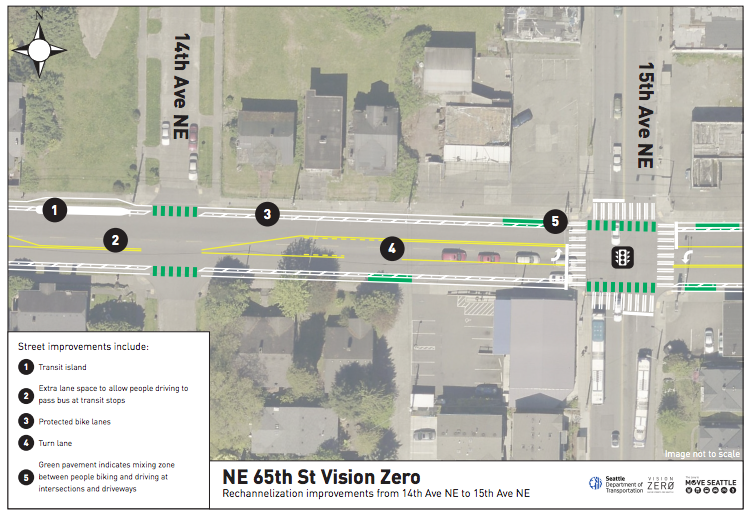
Fast forward nearly two years, and the Seattle Department of Transportation (SDOT) is finally releasing design illustrations of proposed changes to NE 65th St. One such illustration, showing the proposed “improvements from 14th Ave NE to 15th Ave NE,” is particularly important. Of the sixty-eight people hospitalized from 2013 to 2016, thirty-one were injured in this section alone. However, the design is simply disappointing, for everyone.
The Problem
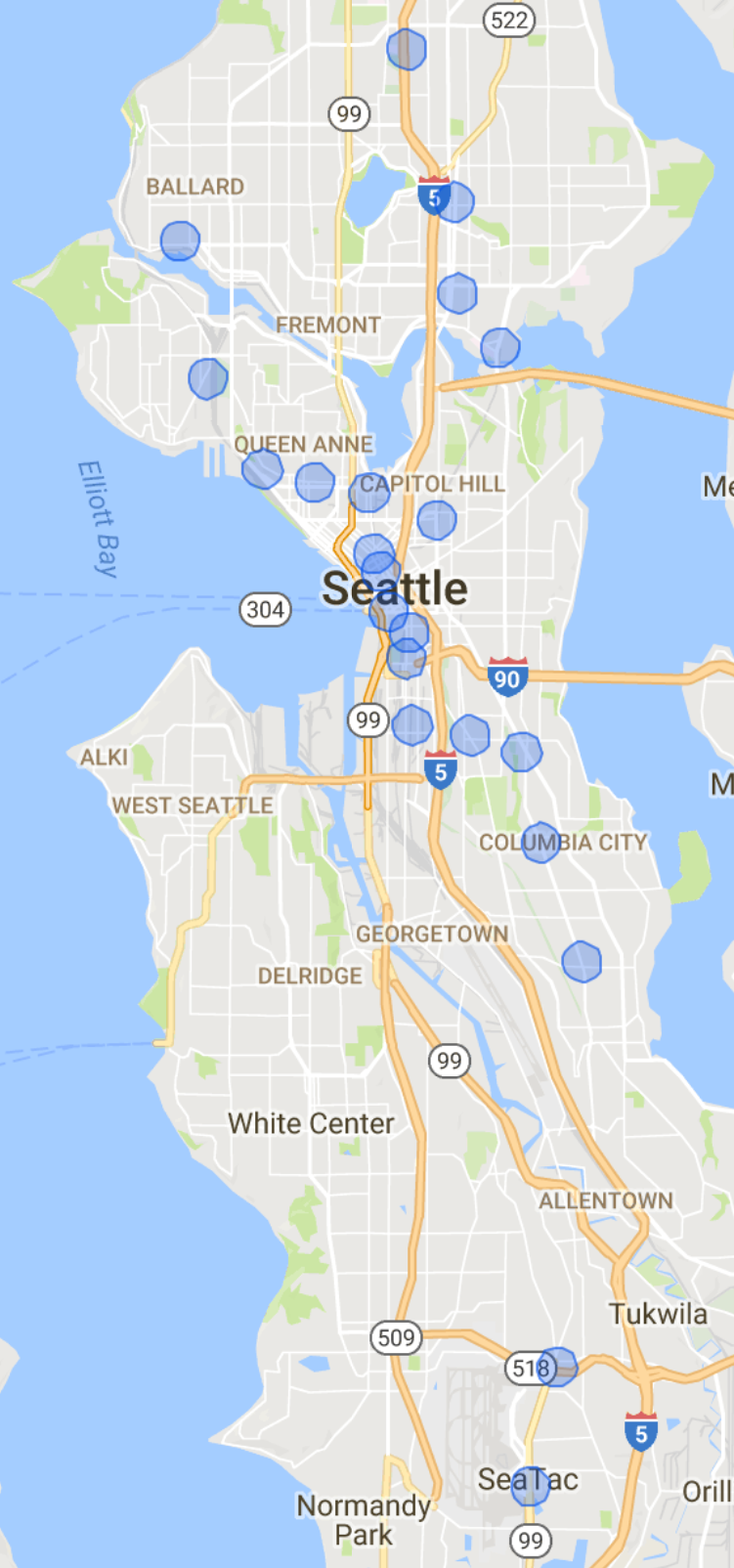
Nearly every concern listed by the neighborhood association is contradicted: parking is removed entirely, neither sidewalks nor planting strips are widened to improve pedestrian safety, speeding is not addressed, and no safe crossing is implemented, despite the proposed addition of a bus stop nearby. One-way bike lanes would replace parking; however, they would be only four feet wide (rather than the recommended minimum width of five feet) and at street level (not sidewalk level, as preferred for safety). In addition, cyclists’ only separation from moving vehicles, on the most dangerous section of a notoriously dangerous street, would be striped painting, and plastic flex posts.
One proposed feature, a center turning lane extending through this street section, has the potential to improve safety at major intersections. However, the center lane is discontinued at the intersection of NE 65th St and 14th Ave NE, to allow cars to pass stopped buses. What is the purpose of a center turn lane when it is discontinued at intersections? This is simply a waste of space. To conclude, nobody wins from this design. But, the biggest losers would be the nearly 2,000 teenagers who attend nearby Roosevelt High School, myself included.
Many of us dream about the freedom of driving: we aspire to get our license, the perfect car, and to drive. Legally, few of us can carpool to school, and those of us that can often don’t. Bussing can take some students nearly an hour, despite their home being only a 15-minute drive away. It is understandable why driving is an attractive option for many students.
However, large volumes of teenagers all driving to school separately creates a problem: parking. Students must arrive 45 minutes early to find parking in the vicinity of the school. Recently, the school parking lot was repurposed for portables, and the remaining parking was designated for teachers only. Multi-story apartment buildings are popping up nearby, as well as a future light rail station. What many students may describe as a parking disaster is becoming more catastrophic by the day. If any parking is removed, a generation of impatient drivers, who already dislike cyclists and bike lanes, will come to truly resent them. While I would love to remove parking and any form of car infrastructure, the majority of Roosevelt students disagree–and it’s the better decision overall to improve their perception of bike lanes, even if it means keeping the parking spaces that incentivize driving.
What Needs to Change
Seattle has a car culture that will only continue if public opinion doesn’t change. Convincing a generation to change their lifestyle is tough. But, it’s even tougher to convince a generation not to drive, when they are finally gaining the ability to do so. Thus, large investments are necessary to make alternative transportation options attractive to students. Rather than removing parking and implementing the proposed street-level bike lanes, the city must extend raised cycletracks down NE 65th St. No other option should be considered, for two reasons.
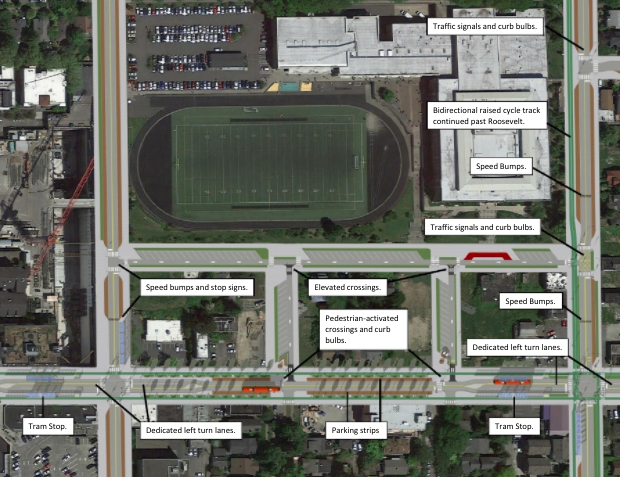
First, it is preferable to invest the resources necessary to truly improve safety once, and only once. The city’s 2013 Bike Master Plan calls for protected bike lanes on NE 65th St, and SDOT should follow through the first time it rebuilds the street (this current process) rather than kicking the can down the road. If not, the city will be compelled to return later and upgrade any lanes to higher-quality raised cycletracks (the gold standard of bike infrastructure). That’s a waste of time and money. The city should do it right the first time. It is simply a bad investment to throw money at a disappointing bike lane, on a notoriously unsafe street, separated by plastic poles, that would have to be replaced later.
Second, raised cycletracks are safer and feel safer than the paint-and-pole Seattle “bike lane.” Given the project’s goal–NE 65th St that is safer for all–shouldn’t investing in the safest possible infrastructure be a logical idea? In addition, safer bike infrastructure makes people more likely to use the lanes–and that’s important on a street that is notoriously unsafe, especially to future light-rail riders and Roosevelt students who may want to use the bike lanes as an alternative to driving. The city should view this as a campaigning opportunity: invest in good bike infrastructure, and public perception of bike lanes will be positively changed forever. If any Seattle resident were to travel to Amsterdam or Copenhagen, they would be amazed at the sheer quantity of cyclists and the quality of their raised bike network. The city should take notes from the places that do bike infrastructure best, and place quality over quantity. Better bike lanes will do a better job convincing students and others why they should stop driving.
To create a truly safe street, widening sidewalks and planting strips is not enough, as those changes do not completely address speeding. Drivers might slow down and increase their alertness due to an increased presence of pedestrians and cyclists in the area, but nothing would physically deter drivers from speeding. The city’s design simply fails to address the fact that this is a school zone. I frequently encounter drivers speeding past Roosevelt High School on 15th Ave NE. No signs are posted informing anyone that this is a school zone, there are no speed bumps, the lanes are wide, and there are no curb extensions at intersections to shorten the crossing distance. The safety hazard from speeding motorists has simply not been recognized or addressed in the city’s current design.
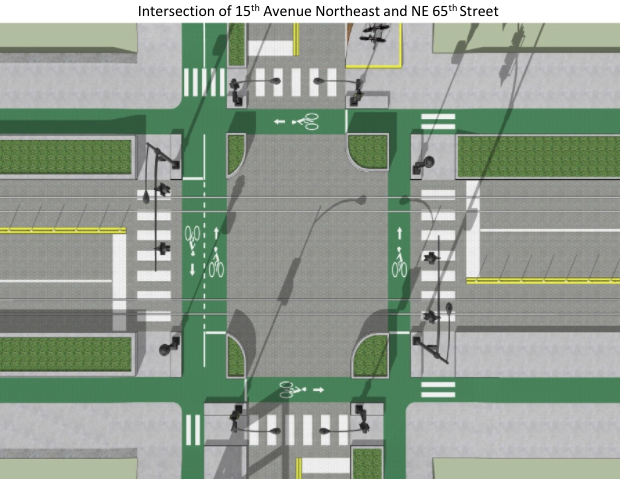
To truly improve safety, textured brick paving should replace the current paving on NE 65th St, 15th Ave NE, 12th Ave NE, and NE 66th St in the area surrounding Roosevelt High School. The paving of parking lanes should be even rougher, to disincentivize drivers from using it as an extension of their lane width (which would allow them to speed up). Another cause of speeding in the area is the designation of 12th Ave NE as a one-way street. Currently, it’s essentially a miniature speedway. This configuration is absolutely unnecessary–the city should just make it a two-way street. Traffic counts provide nowhere near adequate support for the street’s current one-way status, and regardless, it should simply be a two-way street. This is a school zone. Cars need to slow down, and contra-flow traffic would do that.
To address speeding on 15th Ave NE and to improve pedestrian safety, speed bumps are a necessity near the school. In addition, traffic lights should be installed at the intersection of 15th Ave NE with both NE 66th St and NE 68th St. Signals would alleviate speeding, while also solving several other problems. For instance, after school, parents pick up their kids on NE 66th St, a one-way street. However, traffic often backs up on 15th Ave NE and blocks their exit, which is a nightmare for parents. Traffic signals would solve the situation, while also reducing speeding and creating safer pedestrian crossings.
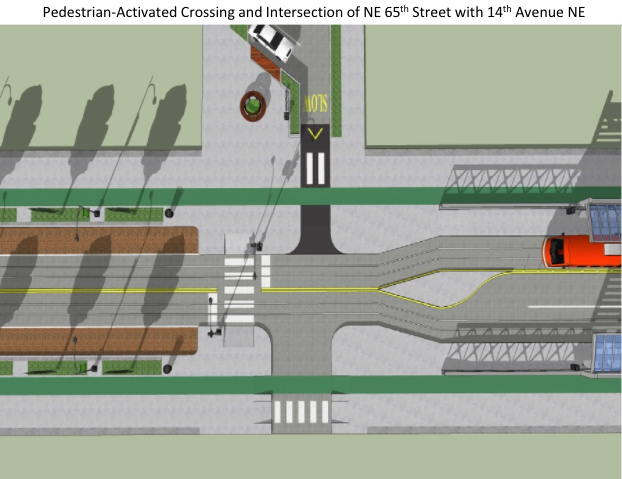
Further up the street at an intersection with NE 68th St, the right-of-way is also given to drivers on 15th Ave NE. There is only one crosswalk at the intersection, and drivers are expected to stop for pedestrians. However, after school swarms of students continuously fill the crosswalk, causing southbound drivers to gradually back up to NE 69th St. Eventually, drivers become frustrated, and thus dart between crossing students, which is obviously a safety hazard. Traffic signals would alleviate traffic congestion and speeding significantly, while also improving safety for crossing students. Curb bulbs should also be implemented, as they improve driver and pedestrian visibility and shorten the crossing distance.
During lunch, many Roosevelt students get food at Roosevelt Square. However, there is simply not enough available waiting space on street corners, particularly those at the intersection of NE 65th St with 12th Ave NE, to accommodate all the students. Students struggle to find room on the sidewalk and out of the street. In addition, left and right turning traffic is held up at this intersection by crossing students. A “pedestrian scramble” timing sequence, where cars get a red light simultaneously while all pedestrians get walk signs, should be added to both this intersection, and the intersection of NE 65th St with 15th Ave NE. This would allow students and light rail users to cross simultaneously, and be on their way. Curb bulbs and pedestrian-activated crossings (where a stoplight turns red when a pedestrian wishing to cross presses a button) should also be added on NE 65th Ave at intersections with both Brooklyn Ave NE and 14th Ave NE, as the volume of crossing students would be distributed away from major, unsafe intersections, improving safety.
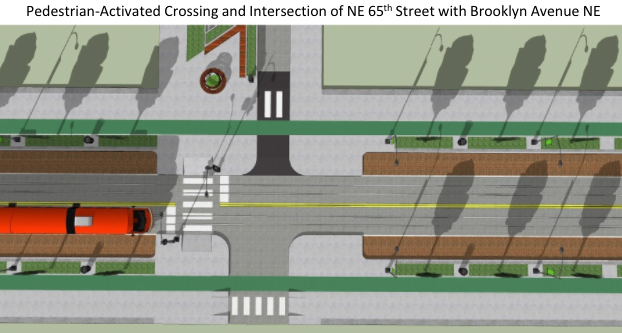
My main proposal, which would greatly improve safety in the area, is the reduction of car lanes on NE 65th St to only one in each direction. Of course, the roadway should be widened to three lanes at major intersections, to provide designated turning lanes. The current four-lane configuration is inefficient. While traffic counts (only barely) provide adequate support for having two lanes in each direction, large volumes of left turning traffic, which must yield to oncoming cars, hold up everyone behind them. This renders the entire left lane essentially useless.
The concepts of induced and reduced demand also provide further support for this proposal. Reducing the number of car lanes may contribute to traffic, which would cause drivers to either travel at a different time, or to not drive at all (and instead walk or bike to the light rail). Meanwhile, widening sidewalks and providing safe bike connections would induce (cause) a greater number of pedestrians and cyclists. These concepts are already in effect all around Seattle.
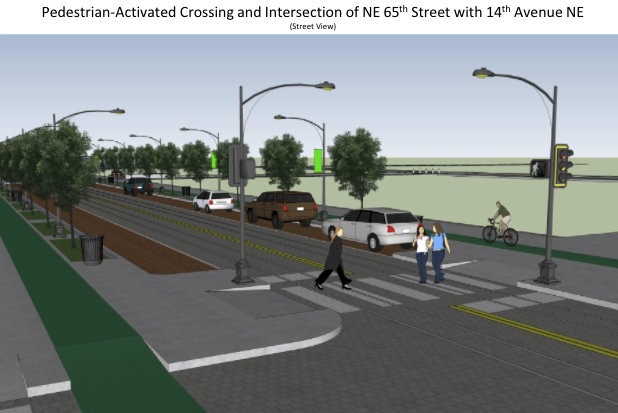
For instance, if you were planning a downtown dinner or movie, you would likely try to schedule your plans outside of rush hour, or perhaps consider light rail. However, if more lanes were added to the highway, would you be less likely to take transit or schedule around rush hour? Probably. Cities are built around incentives, and good cities incentivize walking, biking, and transit–the transportation modes that most benefit traffic flow, businesses, the environment, public health, and safety. Reducing the number of lanes on NE 65th St would essentially eliminate the possibility of side-swipe collisions, would create room for better walking and biking connections to Roosevelt and the light rail station, and would also reduce the crossing distance, improving safety at crosswalks and intersections.
My design illustrations also propose a streetcar line on NE 65th St, which I believe would benefit businesses, light rail riders, and students, while also creating connections between the Woodland Park Zoo, Greenlake, and Magnuson Park. The focus of this article is safety improvements in the Roosevelt area. As to why I propose a streetcar over a simple bus route is a different topic, which I’ll perhaps leave for a different article.
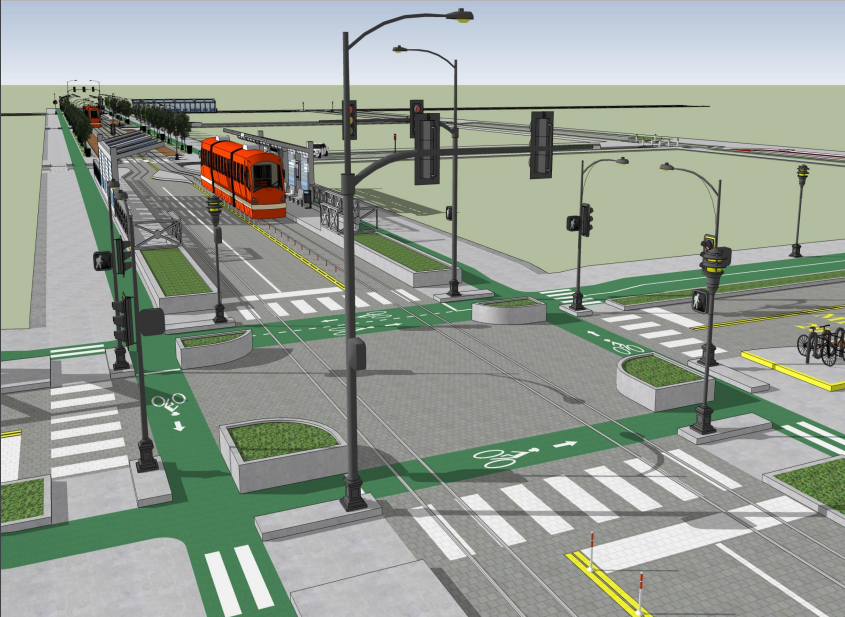
SDOT’s Plan Is Not Enough
While we should be grateful for the work Councilmembers Johnson and O’Brien have done to scrape together funding for improvements on this street, it is simply not enough. Just widening the sidewalks in the above-mentioned section alone would cost nearly $20 million, and the current budget slightly less than a quarter of that–only $4 million. If the city doesn’t have the capital to invest in high-quality infrastructure, it should search for alternative sources of funding. It is astonishing to me that, given the soaring tax revenue and chronic traffic citywide, the booming development in the area surrounding Roosevelt High School, and the unsafe conditions of the area, greater funds cannot be raised for the large-scale changes which need to be made.
Joe Mangan is a junior at Roosevelt High School who fell in love with trams and cycletracks while visiting Amsterdam. He’s been using Sketchup design software since the second grade and is currently working to design a backyard cottage for his family to build and rent out.
Joe Mangan (Guest Contributor)
Joe Mangan is an urban studies and political science double major at Vassar College. He organized the Seattle Climate Strike, led weekly strikes outside Seattle City Hall as the founder of Fridays for Future Seattle, and was later a coordinator with the Seattle for a Green New Deal campaign. His redesign of NE 65th Street was declared “Better Than SDOT’s” by the Seattle Bike Blog.

